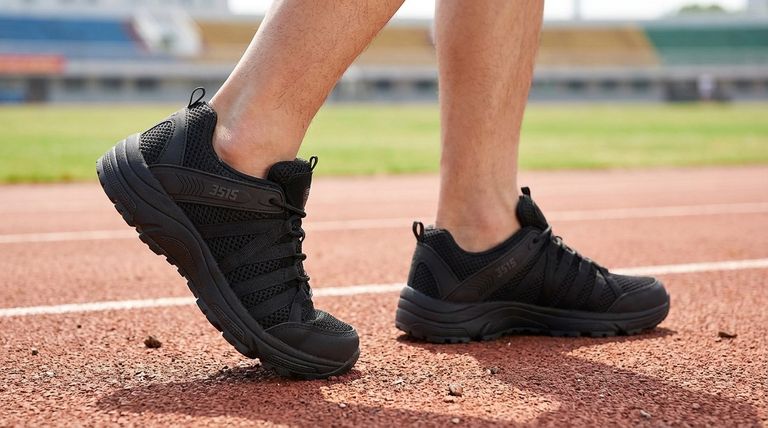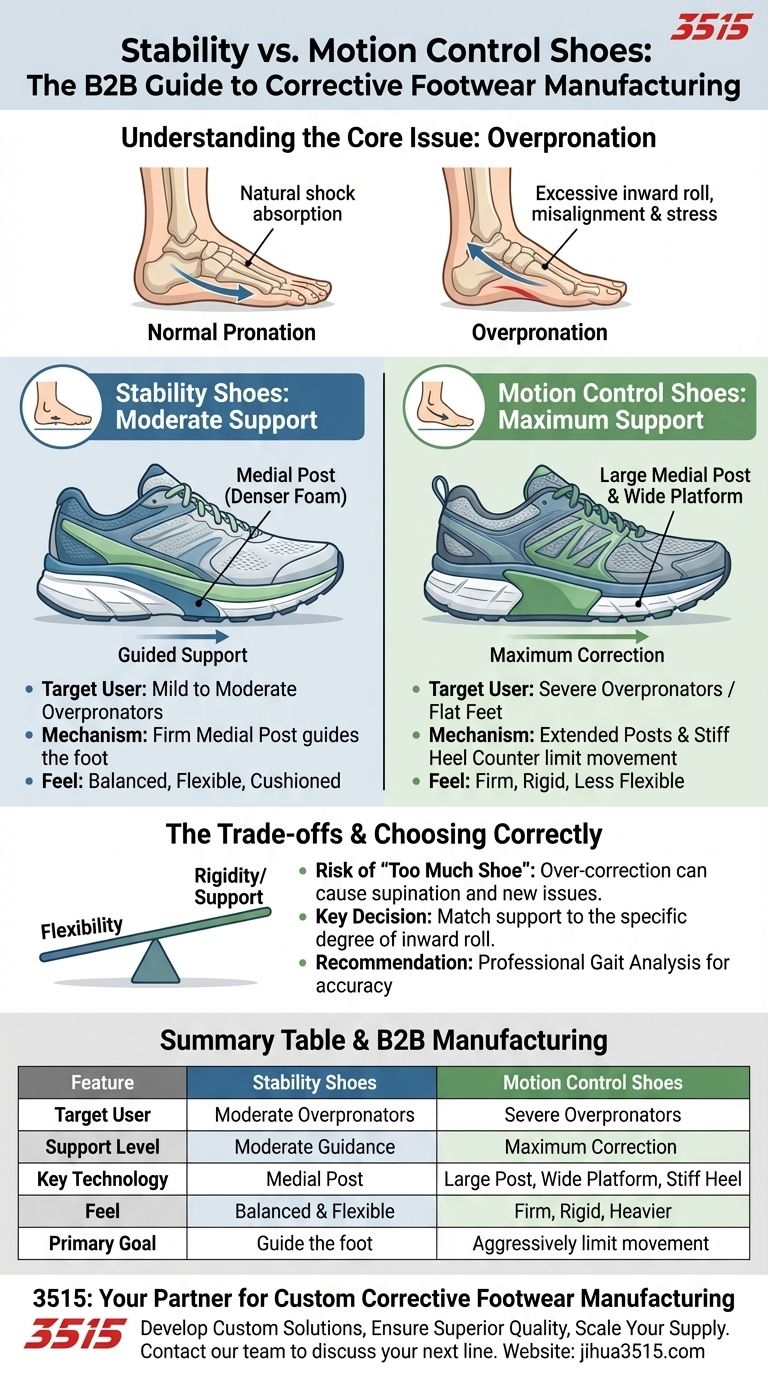The fundamental difference between stability and motion control shoes lies in the degree of support they offer. Stability shoes are designed to provide moderate support for mild to moderate overpronation, while motion control shoes offer maximum support to correct severe overpronation.
Choosing between stability and motion control isn't about which is "better," but about accurately matching the level of corrective technology to your foot's specific degree of inward roll. Using the wrong level of support can be just as problematic as having no support at all.

Understanding Pronation: The Core Issue
Before comparing the shoes, it's critical to understand the problem they are designed to solve: overpronation.
What is Pronation?
Pronation is the natural and necessary inward roll of your foot as it transitions from heel-strike to toe-off during a walking or running stride. This motion helps your body absorb shock.
What is Overpronation?
Overpronation occurs when the foot rolls inward excessively. This can misalign the leg and lead to stress on the foot, ankle, shin, and knee, increasing the risk of injury. Both stability and motion control shoes are built to counteract this.
A Closer Look at Stability Shoes
Stability shoes are the most common type of supportive running shoe, addressing the needs of the majority of overpronators.
The Target User: Moderate Overpronators
These shoes are for individuals whose feet and ankles show a noticeable but not extreme inward roll during their stride.
How They Work: Guided Support
Stability shoes typically incorporate a firm piece of foam, known as a medial post, on the inner side of the midsole. This denser material compresses less under pressure, providing a subtle "guide" to keep the foot from rolling too far inward.
The Feel: Balanced and Flexible
The goal of a stability shoe is to provide support without being overly rigid. They blend cushioning and guidance, offering a supportive feel that is still flexible enough for a comfortable run.
A Closer Look at Motion Control Shoes
Motion control shoes represent the most robust support category, reserved for a smaller segment of the population.
The Target User: Severe Overpronators
These shoes are engineered for individuals with significant overpronation, which is often associated with having very flat feet.
How They Work: Maximum Correction
Motion control shoes use much larger and denser medial posts that extend further along the shoe. They also feature wider platforms and stiffer heel counters to aggressively limit excess movement and force the foot into a more neutral alignment.
The Feel: Firm and Rigid
The trade-off for maximum support is a significant reduction in flexibility. These shoes feel much stiffer, heavier, and less cushioned underfoot compared to stability or neutral shoes.
Understanding the Trade-offs
Selecting the right support level is crucial, as choosing incorrectly can introduce new problems.
The Risk of "Too Much Shoe"
Using a motion control shoe when you only need mild stability can over-correct your stride. This can force your foot into an unnatural outward roll (supination), shifting stress to other joints and muscles.
Flexibility vs. Rigidity
The core trade-off is simple: as corrective support increases, shoe flexibility and weight almost always decrease. A motion control shoe prevents your foot from moving, which is its primary job, but this comes at the cost of a natural-feeling stride.
The Need for a Proper Assessment
Self-diagnosing your level of pronation can be difficult. Observing the wear pattern on your old shoes or having someone watch you run can provide clues, but it is not a definitive method.
Making the Right Choice for Your Foot Type
Your selection should be based entirely on your unique biomechanics.
- If you notice a slight inward ankle roll or uneven wear on the inside edge of your shoes: A stability shoe is the appropriate starting point for providing gentle guidance.
- If you have very flat feet or your ankles roll in significantly with each step: A motion control shoe may be necessary for the maximum corrective support you need.
- If you are unsure, new to running, or experiencing pain: The most reliable path is to visit a specialty running store for a professional gait analysis.
Ultimately, understanding your foot's unique motion is the first step toward choosing the right tool for a comfortable and injury-free stride.
Summary Table:
| Feature | Stability Shoes | Motion Control Shoes |
|---|---|---|
| Target User | Mild to Moderate Overpronators | Severe Overpronators / Flat Feet |
| Support Level | Moderate Guidance | Maximum Correction |
| Key Technology | Medial Post (Denser Foam) | Large Medial Post, Wide Platform, Stiff Heel |
| Feel & Flexibility | Balanced Support & Flexibility | Firm, Rigid, Heavier |
| Primary Goal | Guide the foot to prevent excess roll | Aggressively limit movement for alignment |
Ready to Manufacture the Right Support for Your Customers?
As a leading large-scale manufacturer, 3515 produces a comprehensive range of footwear for distributors, brand owners, and bulk clients. Whether your target market needs precise stability shoes for moderate overpronators or durable motion control shoes for maximum support, our production capabilities encompass all types of shoes and boots to meet your exact specifications.
Partner with us to:
- Develop Custom Solutions: Tailor support levels, materials, and designs to your brand's unique needs.
- Ensure Superior Quality: Leverage our expertise in corrective footwear manufacturing for durable, high-performance products.
- Scale Your Supply: Meet market demand with our reliable, large-volume production capacity.
Let's discuss how we can bring your next line of supportive footwear to life. Contact our team today for a consultation!
Visual Guide

Related Products
- Lightweight Breathable Training Shoes for Wholesale & Custom OEM Manufacturing
- Wholesale Breathable & Cushioned Training Shoes Custom Factory Production
- Wholesale Breathable Training Shoes Custom Athletic Footwear Manufacturer
- Durable Rubber-Soled Utility Shoes for Wholesale & Custom Brand Manufacturing
- Premium KPU Athletic Safety Shoes for Wholesale
People Also Ask
- Why are running shoes and walking shoes not interchangeable? Avoid Injury with the Right Footwear
- What should be considered when choosing smart trainers for business casual? A Guide to Professional Style
- What are the benefits of athletic-style work shoes? Boost Comfort and Safety for Your Team
- Does more ground contact area mean better support? Unlock the Secrets of Stable Footwear
- What is high-tech 'air' mesh, and how is it used in footwear? The Key to Cool, Lightweight Shoes



















